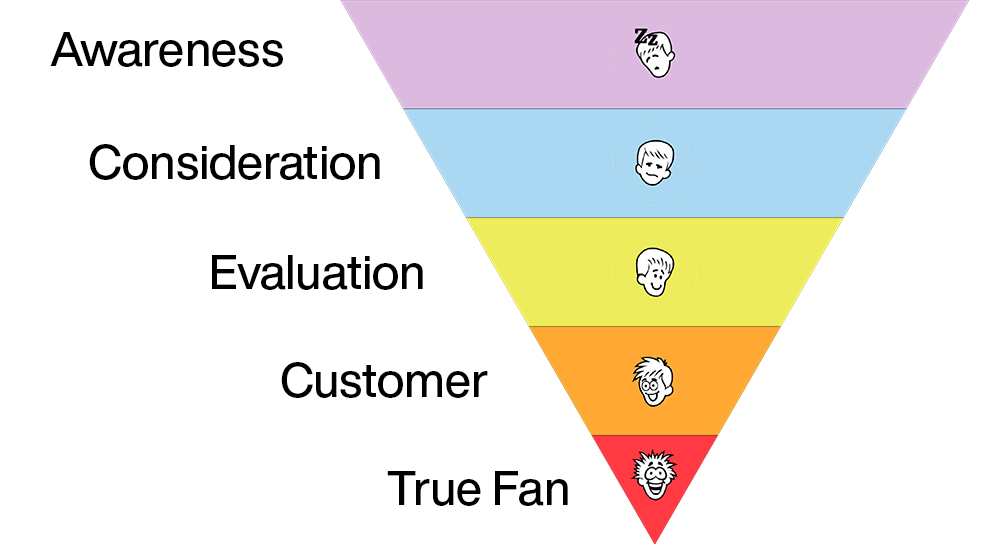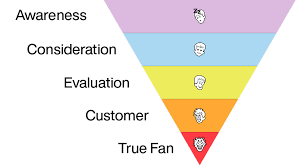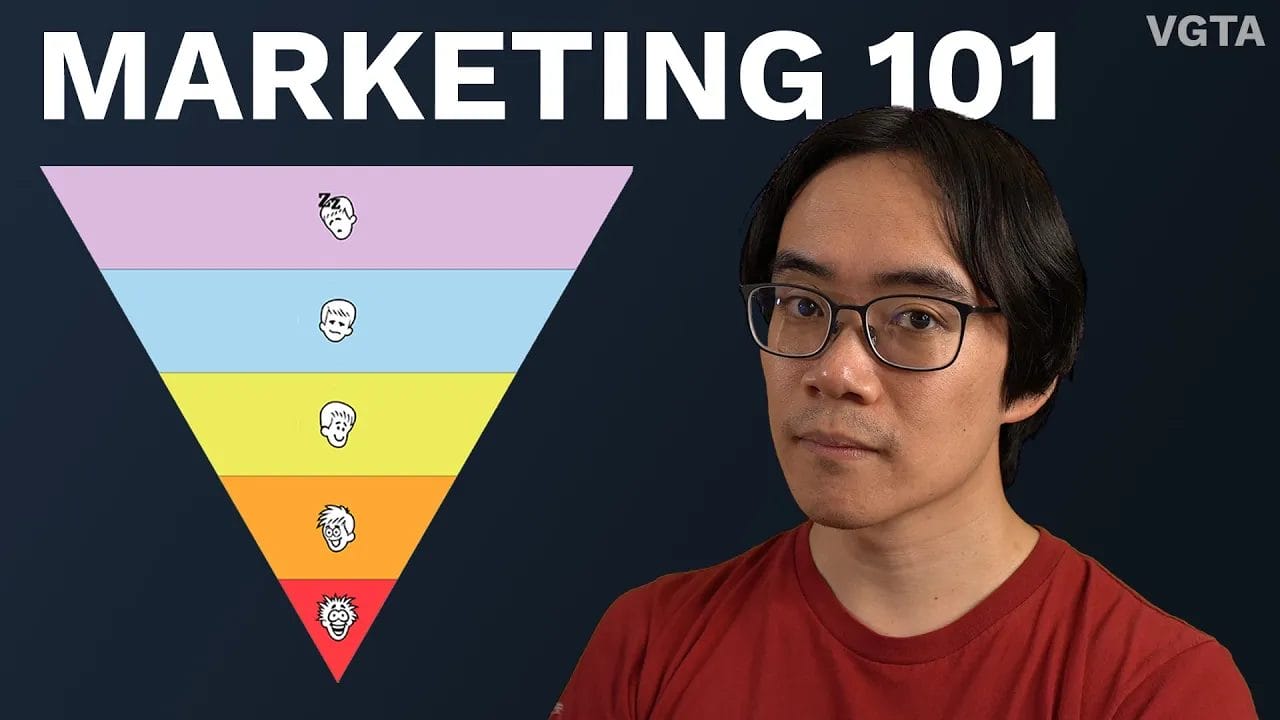How to Know What Kind of Game Trailer to Make or Using the Marketing Funnel to Design a Trailer Campaign
One of the biggest hurdles that game developers have now a days, is how to make their game visible in the ocean of other games that are competing for the attention of the same players. Being able to call for that very limited span of attention is very complex, and to be able to reach that objective trailers are on of the best tool that a game developer have.
How to Know What Kind of Game Trailer to Make In order to know who to target your game trailers to, you need to learn about the sales funnel.
There are a lot of articles, videos, and talks about how to make a good game trailer, but the problem is there are also a lot of TYPES of game trailers… each of which serve a different purpose and audience. Because the question isn’t: “What is the best type of game trailer?”
The question is: “What are the best TYPES of game trailers?” To answer this question, you need to understand that different people will react to different things. There is a very interesting TED’s talk Malcolm Gladwell’s talk about spaghetti sauces which using the analogy of spaghetti sauces, there is no one-size fits all spaghetti sauce for everyone in the world, because we all have different tastes and needs. Some people like Italian seasoning, some like thin and runny, and others like extra chunky.
The same goes for game trailers.
Most of the advice geared toward making trailers are for people, who will only ever make one or two trailers for their game, but when you have the time or budget to make more trailers and videos, you need to know some basic marketing concepts to help guide you to the right design choices.
Namely, the sales funnel. It has other names like the purchase funnel, conversion funnel, marketing funnel, customer funnel, but they’re all the same concept. The funnel that is used as a reference into the article is the one by Chris Zukowski from HowToMarketaGame.com.

The Sales Funnel
The funnel describes the journey potential customers go through… from first learning about a game all the way to their decision to purchase or not.
The visual is a funnel because every step of the way… there are fewer and fewer people engaged with the game or even paying attention. It’s more like a series of sieves if anything, but that doesn’t sound as catchy. Calling this a funnel is much more for the visual rather than referencing the actual real-life object, because of course if you pour something into a real funnel, all of the contents put into the top will come out the bottom.
Every potential customer starts at the top of the funnel; this is where they become aware of a game via a trailer, news article, social media post, animated GIF, YouTube video, streamer, almost anything which shows or talks about the game.

If their interest is picked, they move onto CONSIDERING whether or not they should devote more attention by: following a social media account, joining a Discord, wishlisting the game on a store page etc.
A step further, they might decide to read articles, watch videos, and maybe even play a demo.
After that they either become a buying customer, or not. And after that, they either play it and don’t really like it, or they might even become fans of the game and the people who made it! The key to making trailers targeted towards the right audience is to understand and serve the needs of the people at the phases of the funnel:
- Are they just learning about the product?
- Are they already following you?
- Are they following, but need more information?
- Are they a new customer?
- Are they already a fan?
Knowing your audience
Knowing who your audience is will help you give them what they want. Let’s dive into each step of the funnel, and what tends to work best to serve the people at those stages.
Step 1 is: Awareness
This is the stage where you’re working off of nothing. No one knows who you are, they might not even be familiar with the genre of game you’re making.
This is where you need to make a trailer which shows how unique the game is, make the message simple to digest, and make the trailer itself as broadly appealing as possible; your goal is to gather as big an audience as you can. As we go through the stages of the funnel, a good way to think about it is that the first trailers give the broad but shallow view, and each one which follows dives a bit deeper. AAA games frequently make their announcements via cinematic trailers. This is because well directed, animated, edited, scored and sound designed trailers with beautiful visuals are very entertaining.
Since most AAA games feature mechanics which are easily understood at a glance, they can afford to be more cinematic, and worry less about conveying unique gameplay ideas (not to say that they don’t ever do this!) I think the best cinematic trailers illustrate gameplay ideas while also looking good. A good example is this trailer for Drake Hollow by Molasses Flood. Cinematic or animated trailers are very expensive to produce whether it’s time or money or both, so a trailer made via the game engine is what most people will make. Announce trailers of that style need to present the clearest and simplest gameplay idea… so it’s very easy to describe and share.
Another good example is the announce trailer for Snow Runner. If you can get a share, follow or wishlist from your announce trailer, you’ve successfully brought some people further into your funnel!
Step 2 is: Consideration
Now that people are aware of the game, they’re going to need something more from the next trailer to help them consider whether or not they really want to purchase the game. This means diving into some specifics which were only hinted at in the announce trailer.
Depending on the type of game, that means making either a story trailer or gameplay trailer.
This part of the funnel is one where you’re likely to lose a lot of people (and that’s ok!) People who were intrigued by the vague but exciting pitch of the announce trailer might not hang on when they realize the gameplay doesn’t fall into their preferred genre.
Or maybe the story didn’t go in the direction they thought it would. For example, the announce trailer for Supergiant Games’ third game Pyre generated a lot of hype, and the trailer is really good with amazing art, music, animation and sound effects. The problem is that if the value proposition is not very clear, when people finally discovers the game is really about people might fell out of the funnel at that stage.
Some developers, to face this, might be tempted to mitigate loss of people in your funnel by remaining more vague with details, but if your trailers are too same-y and vague then you risk frustrating or boring the people who want more information. It’s important to continue to play to your unique hooks, and strengths.
Some games present well enough in hype trailers like Spelunky 2, while others might be just unfamiliar enough in concept that they require more explicit explanation like Creature in the Well or Tactical Breach Wizards. Story trailers need to go a little bit deeper into what happens in the game in order to serve people at this phase. If a story trailer still feels like it only presents a world and an idea, then it’s likely to be unsatisfying.
For example, the announce trailer for Firewatch presented the idea of a fire lookout in a situation where something went wrong. For the second trailer, we wanted people to know there’s a mystery, and that events will be actively unfolding during the course of the game.
This was to differentiate it from other first person games which focused on uncovering past events.
Firewatch’s E3 trailer introduced the idea of some missing girls, a cut communications wire, and a mysterious person invading your lookout tower.
Every potential customer starts at the top of the funnel; this is where they become aware of a game via a trailer, news article, social media post, animated GIF, YouTube video, streamer, almost anything which shows or talks about the game.
DELILAH: Wait, you’re already there? DELILAH: You’re not in your tower?
DELILAH: Wait, you’re already there?
DELILAH: You’re not in your tower?
HENRY: No, I’m not. DELILAH: Then who is?
This part of the funnel is about informing and hyping people up. Holding attention is probably the most difficult thing to do, because people get impatient without new content; you need to strike a balance between satisfying the audience, while not spoiling anything about the game.
Evaluation of Actions
Next step in the funnel is: Evaluation This is the final step before the purchase. If someone is still paying attention at this point they… either need even MORE detail to help them evaluate the game, or they’re along for the ride, and just want to get excited.
People with lingering questions might be well served by making Gameplay Overview or 101 trailers. Again, Snow Runner had a very good array of gameplay videos, and Deus Ex: Human Revolution had its 101 trailer explaining the different play styles you can employ. This is also a good time to make trailers for things peripheral to the gameplay trailers.

Like behind-the-scenes looks at the game and its design choices.
For example, take a look at these videos which lead up to the release date of The Last of Us Part II. You can see each video is longer form and more in-depth than what you get from a typical hype trailer, and discusses more granular things about the game. These videos scratch the same itch I had as a kid when… I was so excited for the game I just purchased that I read the manual as my mom drove me home before she inevitably stopped at the grocery store first.
The last thing to hopefully get people to purchase is the launch trailer which either sums up everything covered so far, or does something big and flashy like an animated trailer or live-action trailer.
How to turn audience into customers
Second to last stage of this funnel is: Customer If you still have people in the funnel who are ready to purchase, congratulations!
There are still trailers you can make to serve the people at this part of the funnel. If the game has additional content or features coming, then you’re going to be making update trailers and DLC trailers. These should be specifically focused on existing customers, and it’s one of the few times when calling out features and quantity of content really works in game trailers.
You might also make celebratory trailers which appeal to people’s confirmation bias; people like seeing opinions they already agree with, and they like feeling good about a purchase they made. This is one purpose accolades trailers can fulfill, even if they’re mainly intended for people who haven’t purchased yet. Last stage of the funnel is: “True Fan” If you’re ever fortunate enough to have a “True fan…” (someone who will buy anything you make sight unseen).
Congrats again! “True fans” will appreciate just about anything you make, but something which feels specifically for them to show your appreciation is a nice gesture.
For example, this anniversary cinematic trailer for Stellaris feels very much like a tribute to the game and the community. You can see in the comments a large number of fans who really enjoyed it!
The term “True fan,” is used as a reference to the audience that is really interested in the game and that will actually be considering buying your game. because I think in the game industry, there’s a lot of talk about people who are and are not “True fans” and there’s a lot of gatekeeping, which is really gross and unnecessary. So the term “True fan” to describe your fans, but it’s just a term that is used in a lot of marketing speak.
.Just to describe people who will buy basically anything that someone puts out, regardless of anything else. So that’s why I use the air quotes. And don’t gatekeep the game industry by saying: “This person’s less of a fan… I’m more of a fan and therefore this person should not exist.”
That sort of thing. Moving on. When you understand the marketing funnel, you’re better equipped to make trailers for your game, because you understand the needs of the people at the different stages of the funnel. It’s a lens which allows you to see and interpret feedback.
For example, People who dislike cinematic trailers for AAA games have that attitude because they quickly move past the Awareness part of the funnel… and immediately crave mid-funnel gameplay content which they can use to consider and evaluate. It is usually better to leave them a little unsatisfied at first because since they’re so ready, they’ll be there when you’re prepared to show more. You need to design the marketing campaign, and pace it in a way which best matches your game, and gives the audience the information they need depending on where they are in the funnel.
Helping customers taking the buying decision
Another way to think of the funnel is: each bit of information is there… to HELP the person decide whether they want to invest more of their time.
For example, not everyone wants to watch a 10 min trailer as their first intro to a game. They might want a 60 sec teaser, which convinces them to watch a 2 min trailer, which convinces them to watch a 5 minute overview, and then maybe they’ll watch dev stream or read blog post. It’s a chain of deeper investments which we hope ends with them… spending their money and time playing the game. Some games can get people to go from teaser trailer to purchase, and that’s great for them, but most people will need more warming up to be sure they want to buy a game. Build awareness with your announce trailer.
Make story or gameplay trailers to help people consider your game. Make detailed overview or dev commentary videos to help people further evaluate the game. Sum it all up with a launch trailer, and get them excited to make the purchase. Show some love and appreciation to your true fans.
The Youtube video
Video TimeStamps
00:00 – Intro
00:12 – There are many types of trailers
01:02 – The Sales Funnel
02:07 – Stages of the funnel
02:53 – How to use the funnel
03:20 – Awareness
04:57 – Consideration
07:44 – Evaluation
09:01 – Customer
09:43 – True Fan
10:13 – The term “True Fan” is kind of gross
10:52 – Concluding thoughts on the funnel
12:13 – Lesson recap
Video byA game developer that wants to share its knowledge and experience with other game developers-





